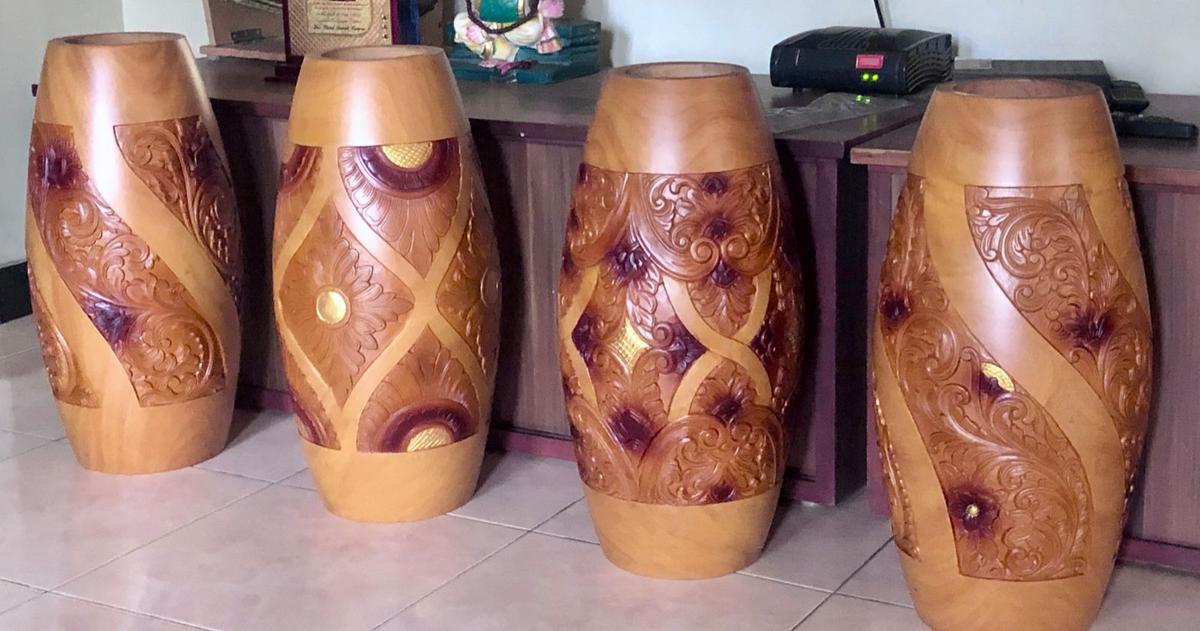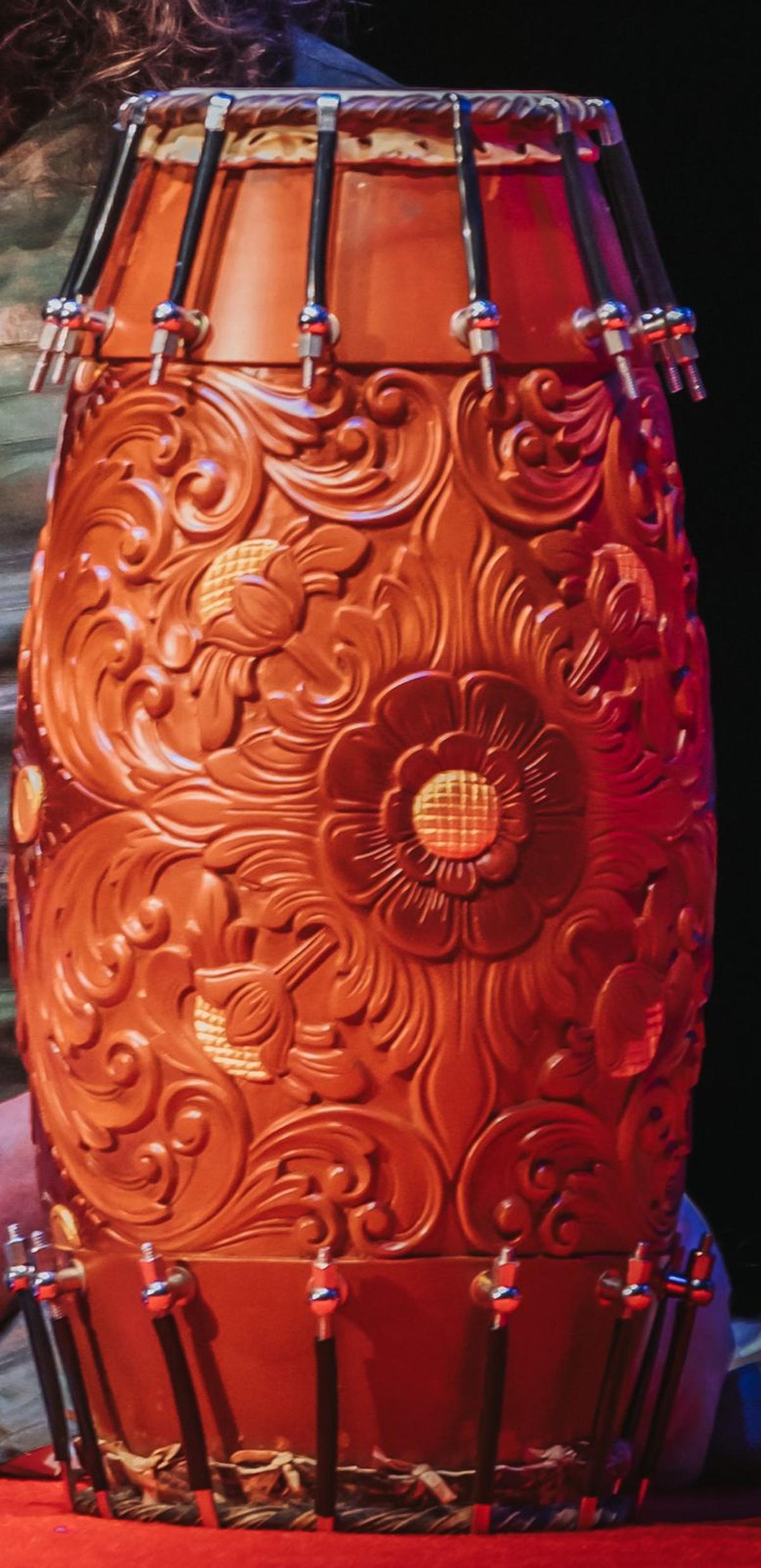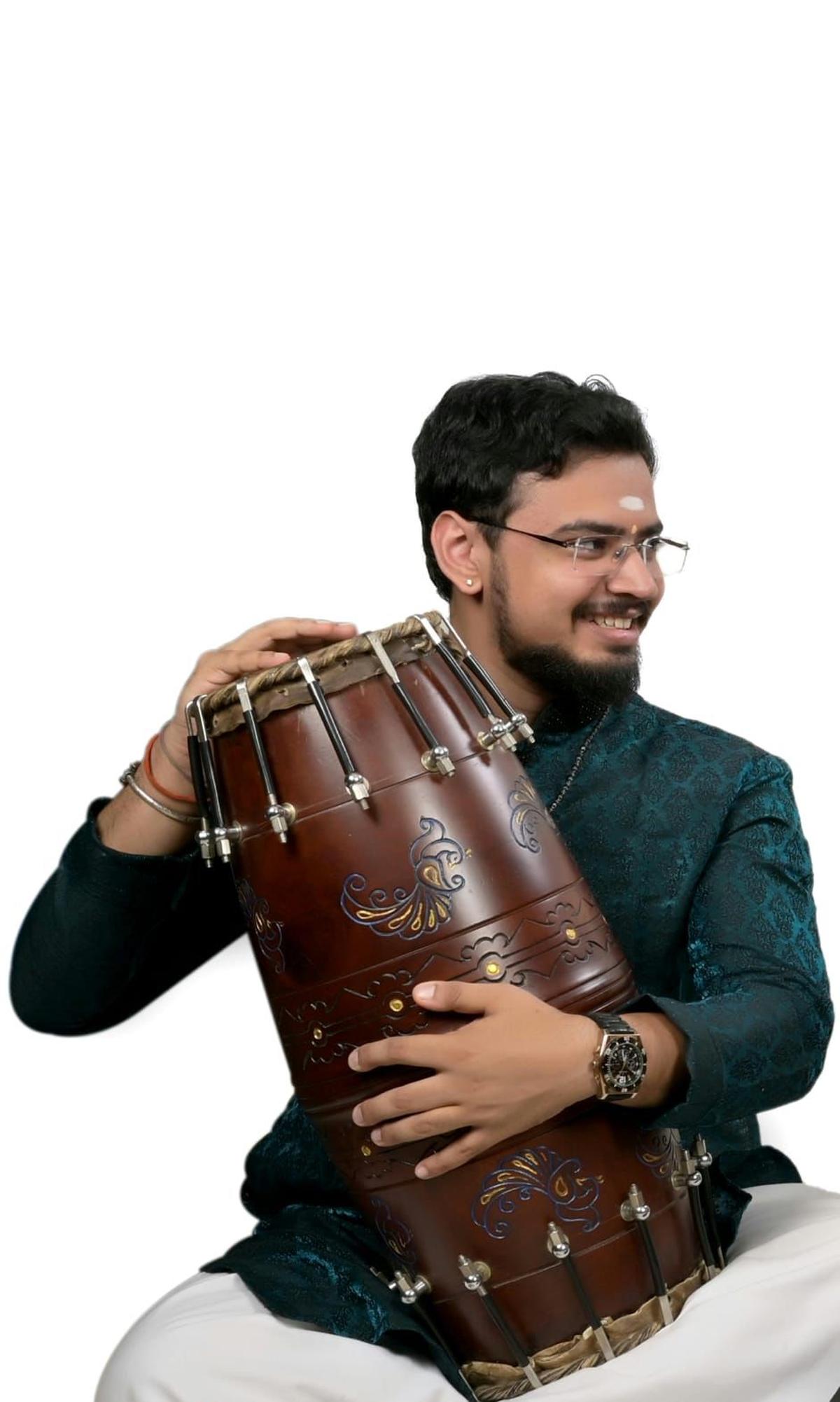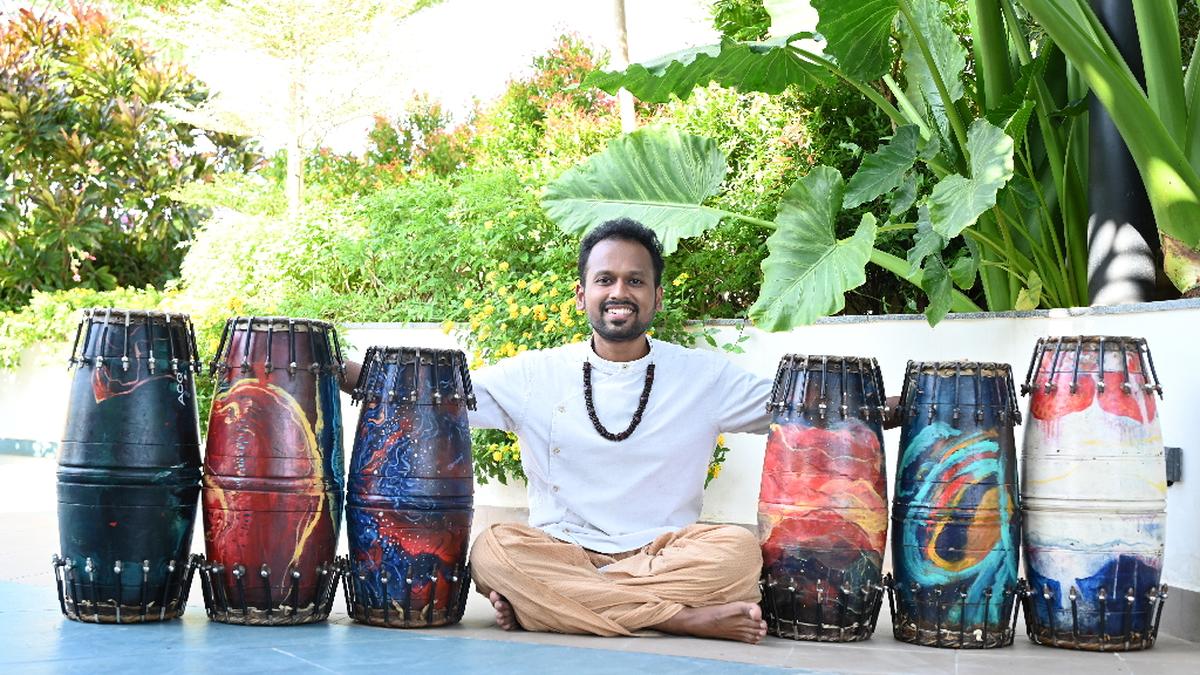In the heart of southern India, where percussion rhythms have long been the heartbeat of diverse musical styles, artists are not only experimenting with sounds but also giving their instruments a new look. For example, some mridangists have transformed their instruments into canvases. This creative idea was inspired by the recent shift from traditional leather strap-bound mridangams to contemporary versions equipped with nuts and bolts. This change left expanses of bare wood on the instruments, inspiring these musicians to explore decorative possibilities. The result is a stunning fusion of visual art and a musical tradition, where each drum not only produces distinct rhythm patterns but also tells a story through its ornate exterior. When these mridangams are placed on the stage, they further add to the aesthetic appeal of the concert.
Patri Satishkumar, who pioneered the trend of designer Mridangam, enhanced its appearance with beautiful carvings. , Photo Credit: Special Arrangement
The virtuoso Satish Kumar, who started this trend a decade ago, also coined the term ‘Designer Mridangam’. “I wanted to do something for the instrument that has given me an identity. So I thought of enhancing its look with beautiful carvings, as is done on Hindustani musical instruments,” says the senior mridangist.
Over the years, mridangam artists Jayachandra Rao, Vinod Shyam Anuar and Nandan Kashyap also adopted it.
Patri Satish Kumar’s exquisite and creative designs are inspired by the traditional art forms of Warli (Maharashtra), Madhubani (Bihar), Kalighat Painting (West Bengal), Patchitra (Odisha) and Kerala murals. These have been meticulously executed by skilled artisans from Thanjavur, Palani, Pune, Kolkata, Bengaluru, Kerala and Mangaluru. “This blend of regional styles exemplifies the rich artistic heritage of India. Despite the challenge of carving a round surface, the artists did a great job,” he says.

Patri Sathishkumar’s mridangam designs are inspired by the traditional art forms of Warli, Madhubani, Patachitra, Kalighat painting and Kerala murals. , Photo Credit: Special Arrangement
Till now, he has worked on more than 50 mridangams, which are part of his personal collection. The first design was actually inspired by African drums. Subsequent designs included divine symbols such as conch, trident, damru, Nandi and geometric shapes. Each pattern was carefully drawn, carved and coated with natural polish mixed with earthy colors – brown, black and gold.

An intricately carved mridangam of Patri Sathishkumar. , Photo Credit: Special Arrangement
In the process of elevating the look, the mridangist decorated the instrument with 3D carvings of the floral motifs found on temple pillars.
Jayachandra Rao’s Mridangam has graphic prints. , Photo Credits: Akhila Easwaran
Jayachandra Rao shares the origins of his 10 musical instruments, painted in bright colors based on nature, divinity and social messages. He invited a hearing-impaired artisan from Andhra Pradesh to his residence in Bengaluru. “The artist was initially confused as he was painting on mridangam for the first time. Therefore, he practiced working on a cylindrical object for about six months. We exchanged our ideas through written notes. I was amazed by his art; His performance was excellent.”
Jayachandra says: “During an informal conversation with the artist, I shared my belief that Hari and Hara are one and the same, and he created a painting featuring a trident, a peacock feather, the third eye of Shiva and the naam of Krishna . Whenever I perform on these painted mridangams, I always think of him.”
The first mridangam that Jayachandra painted was made by Bengaluru-based artist Seemantini, who specializes in Ganjam murals – an art form that originated in Odisha. He depicted Nandikeshwara and inscribed 108 names of the deity in white paint on a dark blue background. Jayachandra explains, “In the first few seconds of the concert, I felt awkward holding Nandi in my lap while playing. However, when I saw the aura formed by the rays of light reflected on Nandikeshwar, I became immersed in devotion. I heard an inner voice, ‘I am your friend. Go ahead and perform”
In a pristine, white-walled, acoustically designed practice space with artefacts and a few watercolor paintings on display, Kumuthavalli, Sakthi, Kishan and Lawrence wait. These are the names of Praveen Sparsh’s Mridangam, illustrated by his friend, visual artist and musician Susha. He has thoughtfully named all the people who have influenced his life. ‘Lawrence’ respects his Mridangam maker. “We exist because of them,” he says. Kumuthavalli is his mother’s name, Kishan is his father’s name, while Shakthi is dedicated to his sound engineer Prakash.
Little did Praveen, who had a penchant for the abstract, know that Mridangam was incidentally featured for his music video Saavari Everyone else will be drenched in colors in 2018.
“I just wanted to give a different take on the traditional instrument. I told Susha that the painting should indicate the mental state of the protagonist in the video. He imagined Shiva and created an abstract painting using deep blue, red, purple and yellow,” recalls Praveen.
Praveen has named his Mridangam after his parents and friends. Photo Credit: Thamodharan B
A recent addition to his collection, a mridangam decorated with geometric patterns and sea-inspired colours, is dedicated to ‘A Karnataka Quartet’, a five-year-old ensemble comprising Praveen, violinist Shreya Devanath, nagaswaram artiste Mylai Karthikeyan and Thavil artistes include Gummidipoondi. R Jeeva and Adyar G Silambarasan, in turn. When asked about the importance of the color palette, Praveen says: “It depends on the subject, the personality of the person and the pitch of the mridangam.”
The response of the rasikas to these unique mridangams has been tremendous. Recalling a performance in London, Praveen says, “A rasika said that the painting of Shiva on the mridangam made her feel the power of the beats. Jayachandra shares: “Many people have also inquired about the reasons and significance behind the design. It constantly inspires me to think of new scenes. Patri said that some of his students and admirers around the world have also purchased some of his Mridangams.

Patri Satish Kumar’s disciple Hariharan has imbibed his guru’s love for fine arts. Photo Credit: Special Arrangement
Apart from learning sports techniques, Petrie’s students – V Sai Raghavan, Hariharan, Deepika Srinivasan and Yashwant Hampiholi – have imbibed this passion. “While playing with Patri sir at a concert in Tirupati, I got a chance to play a solo song called ‘Chakra’, which inspired me to design the Srichakram and Trisulam on my mridangam,” he says. Said that now one of his students has a painting of Muruga flat (spear) and a peacock feather on the mridangam.
When asked how experienced percussionists responded to these artistic interventions, Petrie said that maestros like Umayyapuram Sivaraman, TV Gopalakrishnan and Karaikudi Mani appreciated the effort. “The artwork has not interfered with the shape, wood quality or alignment of the instrument. It just reiterates how the arts are interconnected and enhance the creative experience,” says author Satish Kumar.
published – October 15, 2024 03:11 PM IST
